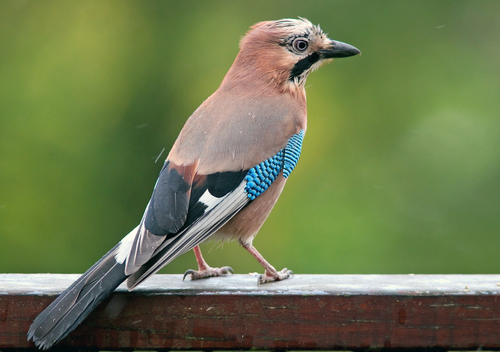
Eurasian Jay
The Eurasian Jay (Garrulus glandarius) is a vibrant and intelligent member of the crow family (Corvidae) found across a vast range of Eurasia. Known for its striking plumage, raucous calls, and remarkable ability to mimic other birds' sounds, the Eurasian Jay plays a crucial role in forest ecosystems as a key disperser of seeds, particularly acorns. It's a highly adaptable bird, thriving in various habitats, and is often recognized for its curious and sometimes mischievous behavior. While not generally considered of high cultural significance in the same way as some other corvids, its bright appearance and vocalizations have made it a familiar and often appreciated part of the landscape.
32-35 cm
Length
52-58 cm
Wingspan
Least Concern
Conservation Status
Distribution
The Eurasian Jay is found throughout Europe, extending into North Africa, the Middle East, and across Asia to Japan and Southeast Asia. It is largely non-migratory, though some northern populations may move south in harsh winters. It can be found at elevations ranging from sea level to mountainous regions, up to the tree line.
Lifespan
The average lifespan in the wild is around 5-7 years, but they can live longer in captivity.
Eurasian Jay's Habitat
Habitat Types
Deciduous woodlands, Mixed forests, Coniferous forests, Parks, Large gardens, Orchards
Climate Zones
Temperate, Boreal, Subtropical
Adaptations
Eurasian Jays are highly adaptable to various habitats. Their strong beaks are suited for cracking acorns and other nuts, and their caching behavior allows them to survive in areas with seasonal food availability. They have excellent spatial memory to relocate their hidden food stores.
Variations
Numerous subspecies exist across the Eurasian Jay's vast range, differing in plumage coloration and size. For example, some island populations or those in isolated mountain ranges exhibit distinct characteristics.
Appearance
Breeding Plumage
Plumage remains largely the same throughout the year.
Seasonal Feather Changes
Minimal seasonal variation; plumage may appear slightly duller after molting.
Sex Based Plumage Differences
Males and females have very similar plumage.
Notable Features
Pinkish-brown body plumage, Bright blue wing patches with black barring, Black and white striped crown feathers that can be raised into a crest, Black 'mustache' stripe, White rump
Diet and Feeding
Primary Foods
Acorns, Beechnuts, Other nuts, Insects, Small invertebrates, Fruits, Berries, Small vertebrates (e.g., nestlings, eggs, small rodents)
Foraging Behavior
Eurasian Jays forage both on the ground and in trees. They are known for their habit of caching food, particularly acorns, burying them in the ground for later retrieval. They use a variety of techniques, including hopping, gleaning, and probing.
Specializations
Their strong beak is well-suited for opening hard-shelled nuts. They also possess a gular pouch, a small sac in the throat, which they can use to carry multiple acorns at once.
Seasonal Diet Variations
In autumn and winter, acorns and other nuts form a major part of their diet. In spring and summer, they consume more insects, invertebrates, and sometimes the eggs and young of other birds.
Behavior
Social Structure
Eurasian Jays are generally found in pairs or small family groups, especially during the breeding season. Outside of the breeding season, they may form larger flocks.
Communication
Harsh, rasping calls, Mimicry of other bird species, including birds of prey, Soft chattering and clicking sounds, Visual displays, such as raising the crest
Migration
Most populations are resident, but some northern populations may undertake partial migrations southward in winter in response to food availability.
Territorial or Group Behaviors
Eurasian Jays are territorial during the breeding season, defending their nesting area from intruders. They are known to engage in mobbing behavior, collectively harassing predators such as owls or cats.
Conservation
Threats
Habitat loss and fragmentation due to deforestation and urbanization, Pesticide use, which can reduce insect prey availability, Hunting and trapping in some regions (though generally not a major threat)
Protection Programs
General habitat conservation measures, Protected area networks, Monitoring programs
Local National Laws
Protected under various national and international wildlife protection laws, such as the EU Birds Directive.
Population Trend
Stable
Population Estimates
The global population is estimated to be very large, with millions of individuals across its range.
Interesting Facts
Eurasian Jays are highly intelligent
They are known for their problem-solving abilities and their capacity for complex social interactions.
They are excellent mimics
They can imitate the calls of various other bird species, often including predators like buzzards, possibly to scare away competitors or warn of danger.
They play a vital role in forest regeneration
By caching and forgetting acorns, they help to disperse oak trees, contributing to the spread and growth of woodlands.
They have a good memory for cache locations
Eurasian Jays can remember the locations of thousands of buried acorns, even months after hiding them.
Faqs about Eurasian Jay
Are Eurasian Jays related to Blue Jays?
Both Eurasian Jays and Blue Jays are members of the Corvidae family (crows, jays, and magpies), but they belong to different genera. Blue Jays are native to North America, while Eurasian Jays are found in Eurasia and North Africa.
What is the purpose of the Eurasian Jay's bright blue wing patch?
The bright blue wing patch serves as a visual signal, likely used in communication between individuals, such as during courtship or territorial displays. It may also play a role in species recognition.
Do Eurasian Jays eat other birds' eggs?
Yes, Eurasian Jays are opportunistic feeders and will sometimes consume the eggs and nestlings of other birds, particularly during the breeding season when they need extra protein for their own young.
Why do Eurasian Jays bury acorns?
Burying acorns, a behavior known as caching, is a way for Eurasian Jays to store food for later consumption, especially during the winter months when food is scarce. This behavior also inadvertently helps with the dispersal of oak trees.
Copyright @ Nature Style Limited. All Rights Reserved.
 English
English